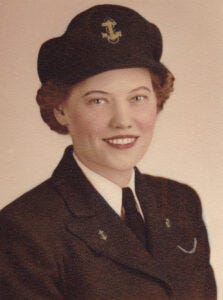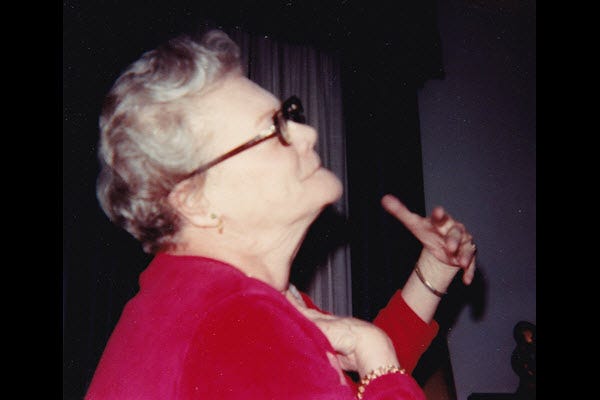Let Your Light Shine (Even from the Closet)
A simple inscription in an old book of poetry led me down an unexpected path.
A simple inscription in an old book of poetry led me to a new understanding of a family member and how to let your light shine, despite challenges you might face.
Bits to Anne with continuing love
The year was 2005. I had been systematically skimming through my modest collection of poetry books. Second Son had a school project.
Down came the slightly yellowed copy of A Treasury of the World’s Best Loved Poems from its place on the shelf. My thoughts turned to the day my cousin Linda had offered me great-aunt Auntie Anne’s books after she died. None of the other cousins wanted them.
I opened the book to see if it contained a poem suitable for the school project. But before I could get to the poems, there was that inscription just inside the cover… Bits to Anne with continuing love.
Huh. Funny I never noticed it before.
I stood there, transfixed, wondering what it could mean. Bitsy had been Auntie Anne’s close friend back in the late 60’s. They had vacationed together every summer for a number of years. The vacation was always taken on a boat—Bitsy’s boat, I assume—off the coast of Maine. Just the two of them, and Bitsy’s young son.
With continuing love. Not something one woman usually said to another. Unless…
Suddenly It Hit Me
Maybe Auntie Anne was a lesbian.
The more I mulled over this theory, the more it explained things.
It explained the odd response I had gotten from Auntie Madge (her sister) when 9-year-old-me had asked why Auntie Anne had gotten a divorce after just one year of marriage. “Marriage and Auntie Anne just didn’t get along,” Auntie Madge had told me.
It explained the decidedly feminist career path she had pursued as a single woman long before feminism was a thing. Albeit one who, since the divorce, had the more-socially-acceptable name of Mrs. Gray.
She had made the not-so-typical choice of volunteering to be a union representative in a factory in the 30’s. And had served in the Navy Waves in the 40’s.
Auntie Anne had gone back to school on the G.I. bill, earning first a BS in 1950, then an MS in Speech Pathology in 1952. This was followed by a rather illustrious career working with cerebral palsy (CP) patients at the D.T. Watson Home for Crippled Children in Leetsdale PA.
She had published a technical paper. She had invented the blo-blok drinking straw attachment to teach mentally challenged children how to suck in the liquid instead of blowing bubbles. In the mid-1960s, she had been invited to Bogota, Colombia to help establish a new program for CP patients. And she had been listed in the First Edition of The Compendium: Persons of Eminence in Exceptional Education.
None of this would raise suspicion in the 21st century, or even in the late 20th century. But it was not typical for women of her generation, most of whom were at home busily raising their baby-boom families.
Being a mom wasn’t the light she had inside her. But Anne Shinn Gray definitely let her light shine in the way she cared for her much-loved CP patients.
She Wasn’t Like Other Women I Knew
Beyond her professional accomplishments, there was her lifestyle and personal style.
Hard drinking. Chain smoking. Always driving a sexy convertible, even into her 60’s.
Short hair. Not mannish, but not fussy or stylish, either.
Always in a suit, either a waist-length jacket and straight skirt, or a similar jacket over a plain sheath dress. Dark colors. Nothing pretty or breezy like my mother wore.
Then there was the way she could, and frequently would, take control of a roomful of gathered family members. She would regale us with stories from her travels and business dealings with great drama and—now that I thought about it—rather manly bearing.
there was that one time, as we were leaving her house after Christmas dinner, when Auntie Anne (smelling of whiskey) had French-kissed my sister.
Had it only been one or two of these things, I could have dismissed it. In fact, it had taken me decades to see the pattern. But now, putting it all together, I could come to no other conclusion.
As the memories came crashing over me in tsunami of insight, all I could think about was how she must have felt having to keep her true self hidden from most of her family.
Who Had the Truth?
I had to know the truth, the real story.
Unfortunately, I had few options left for finding the truth. So many of those who would know had passed away, years before. My mother, my grandmother (Madge and Anne’s sister), Madge, Anne herself, Madge’s husband Paul… all of them were gone.
I had moved to another state and lost touch with the cousins in my generation. After almost a decade of silence between us, I had no contact information for any of them. (And Facebook wasn’t a thing yet.)
My only real option for getting the truth was my dad. But he was suffering from dementia. I called my step-mother, Lois. She and my dad had gotten married not long before Auntie Anne had passed.
I asked Lois, “Was Anne a lesbian?” With no information of her own, she promised to ask my dad when he was having a lucid moment. Surely he would know.
Lois called back a few days later. He had told her, “I always suspected, but I was never sure.”
Say what???
My mom had been close to Auntie Anne. She had done Anne’s Christmas shopping for years. Growing up, she had lived at Madge and Paul’s house for a time. Probably Anne had been living there, too.
So how could my dad not know the answer to this question?
She Spent Her Whole Life in the Closet
How deeply had Auntie Anne had to bury herself in the closet? How horrible was it for her to have to guard her words on certain topics? How disheartening to have to sneak away to be with someone she loved?
What must she have gone through?
What was worse, I wasn’t sure how supportive I could have or would have been had I known the truth while she was alive. I had gone through a pretty judgmental, ultra-conservative phase in my 20’s. (Auntie Anne died when I was about 30.)
I drew comfort from the fact that at least her sister and brother-in-law, Madge and Paul, had stayed close to her. I had spent untold hours at the various houses the three of them shared over the course of their lives. Pooling their money together, it had been a mutually beneficial arrangement.
I also drew comfort from the fact that I knew Auntie Anne to be a woman of great faith. She had had a spiritual experience, a vision, involving the Angel Gabriel, that had given her a remarkable sense of mission and determination. Anne never doubted that God was with her and that the work she was doing with CP children was her unique contribution to the world.
She changed the lives, and the families, of “her” kids. Dolly (Verlinda), Moe, and so many other CP patients she helped took the place of children in her life. And under her expert care, they lived much longer, happier lives than anyone ever expected.
I Took My Cue from Her
Auntie Anne showed me what it was to be a professional woman who wasn’t afraid to let her light shine, using every talent God had provided. After a childhood spent watching her being bold and brash, and succeeding in a man’s world, I never felt any hesitation in reaching for my own professional dreams.
Even now, when I watch Danica McKellar inject little bits of mathematical encouragement into every Hallmark movie she’s been in, it reminds me that math-phobia among pre-teen and teenage girls is still a thing. But it never was for me.
I graduated from Carnegie-Mellon University with a Bachelor’s in Applied Math in 1976. Out of the class of 100 who graduated with Math degrees that year, I was one of four females. Auntie Anne showed me the way.
No, Auntie Anne never, ever hid her light under a bushel. Just her sexuality. I still feel bad about it.
What I Learned from Auntie Anne
There are lots of layers to this story relating to identity, courage, and making an impact despite constraints. Here are some takeaways:
We can’t wait for society to rise to our level. We have to courageously do what we can to live as authentically as we can.
We won’t always get to see the effect our life has on others. We just have to trust that will be true.
The expected path isn’t the only route to a life of meaning. We shouldn’t be afraid to take the path that feels right for us.
Children learn lessons by watching. Be mindful of what you’re teaching them.
It’s always worth it to connect with our elders while they are with us, to ask questions and just listen. Some day it will be too late.
What’s Your Takeaway?
What part of Anne’s story resonates most with you? Please share in the comments.
Hope you are enjoying this series: “The Wisdom in Our Breadcrumbs—A Trail Lit Mostly with Love.”
Know someone who needs to hear this message? Please share or restack.
Thanks for subscribing to Spiritual Life Storyteller! Subscribe for free to get weekly updates and links to the latest stories, and to be eligible to participate in subscriber-only chat threads.
Getting too much email? Click here to update your preferences. If you select only Fractal Fridays, you’ll get a once-a-week email that will include excerpts of anything else I’ve written.










Sharon:
There is so much variability in the people in our lives. I have found that there is too much to learn about each other to allow our interpersonal experiences to be sidetracked by what in reality are meaningless labels. If we concentrate on learning about each other, rather than being hung up over our differences, we generally will be happier and project the same to those around us. I have often fallen into the destructive pigeon-holing of, “ enemies”, “nasty”, “manipulative”… co-sojourners in contact with my life. I can say unequivocally that every one of these has hurt me.
Whether your aunt was, whatever, ultimately has no bearing on your history or relationship with her. That’s just a reflection of post-modern society’s obsession with labeling people to divide.